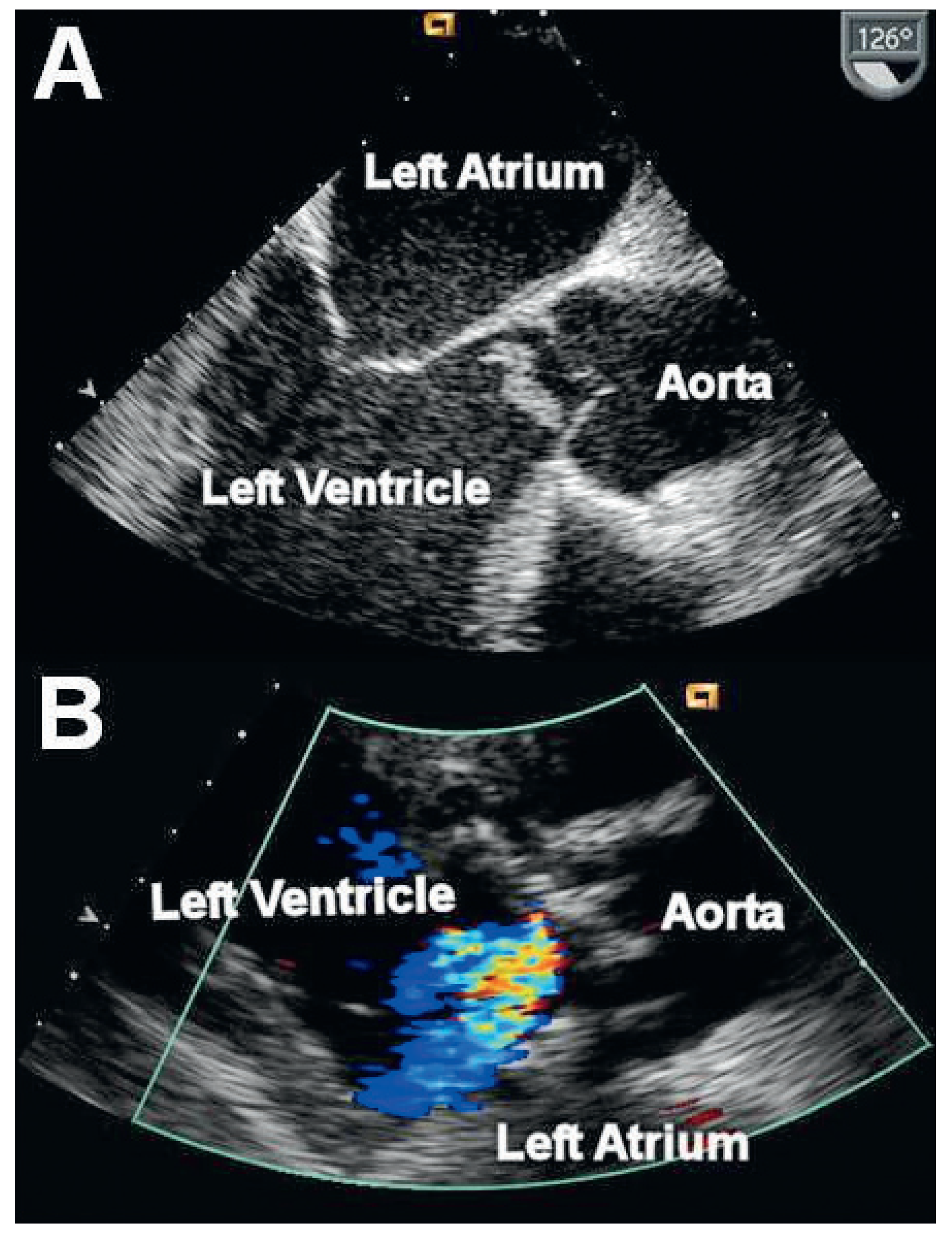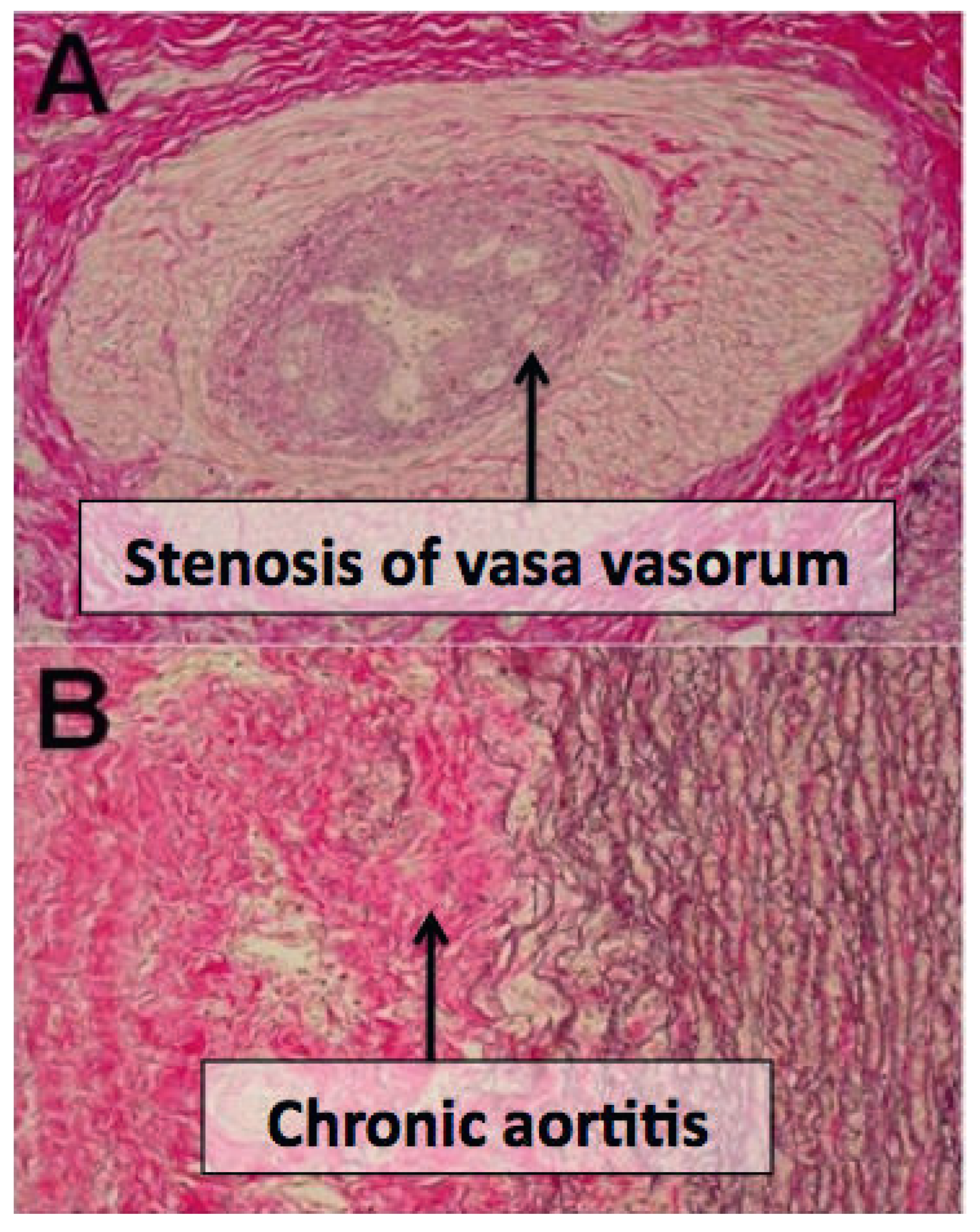Morbus Behçet Associated Aortitis Mimicking Infective Endocarditis
Abstract
Case report
Discussion
Funding/Potential Competing Interests
References
- Shiran, A.; Zisman, D.; Karkabi, B.; et al. Behcet’s aortitis mimicking aortic valve endocarditis with subaortic complications. J Am Soc Echocardiogr. 2006, 19, 578.e1–578.e4. [Google Scholar] [CrossRef] [PubMed]
- Tsui, K.L.; Lee, K.W.; Chan, W.K.; et al. Behcet’s aortitis and aortic regurgitation: A report of two cases. J Am Soc Echocardiogr. 2004, 17, 83–86. [Google Scholar] [CrossRef] [PubMed]
- Han, J.K.; Kim, H.K.; Kim, Y.J.; et al. Behcet’s disease as a frequently unrecognized cause of aortic regurgitation: Suggestive and misleading echocardiography findings. J Am Soc Echocardiogr. 2009, 22, 1269–1274. [Google Scholar] [CrossRef] [PubMed]
- Okada, K.; Eishi, K.; Takamoto, S.; et al. Surgical management of Behcet’s aortitis: A report of eight patients. Ann Thorac Surg. 1997, 64, 116–119. [Google Scholar] [CrossRef] [PubMed]
- Criteria for diagnosis of Behcet’s disease. International Study Group for Behcet’s Disease. Lancet 1990, 335, 1078–1080.
- Marzban, M.; Mandegar, M.H.; Karimi, A.; et al. Cardiac and great vessel involvement in “Behcet’s disease”. J Card Surg. 2008, 23, 765–768. [Google Scholar] [CrossRef] [PubMed]
- Ando, M.; Kosakai, Y.; Okita, Y.; Matsukawa, R.; Takamoto, S. Surgical treatment for aortic regurgitation caused by non-specific aortitis. Cardiovasc Surg. 1999, 7, 409–413. [Google Scholar] [CrossRef] [PubMed]


© 2011 by the author. Attribution - Non-Commercial - NoDerivatives 4.0.
Share and Cite
Bindera, R.K.; Stolta, V.; Englbergerb, L.; Aeberlic, D.; Walpotha, N.; Janzend, J.; Allemanna, Y. Morbus Behçet Associated Aortitis Mimicking Infective Endocarditis. Cardiovasc. Med. 2011, 14, 264. https://doi.org/10.4414/cvm.2011.01613
Bindera RK, Stolta V, Englbergerb L, Aeberlic D, Walpotha N, Janzend J, Allemanna Y. Morbus Behçet Associated Aortitis Mimicking Infective Endocarditis. Cardiovascular Medicine. 2011; 14(9):264. https://doi.org/10.4414/cvm.2011.01613
Chicago/Turabian StyleBindera, Ronald K., Valerie Stolta, Lars Englbergerb, Daniel Aeberlic, Nasan Walpotha, Jan Janzend, and Yves Allemanna. 2011. "Morbus Behçet Associated Aortitis Mimicking Infective Endocarditis" Cardiovascular Medicine 14, no. 9: 264. https://doi.org/10.4414/cvm.2011.01613
APA StyleBindera, R. K., Stolta, V., Englbergerb, L., Aeberlic, D., Walpotha, N., Janzend, J., & Allemanna, Y. (2011). Morbus Behçet Associated Aortitis Mimicking Infective Endocarditis. Cardiovascular Medicine, 14(9), 264. https://doi.org/10.4414/cvm.2011.01613



